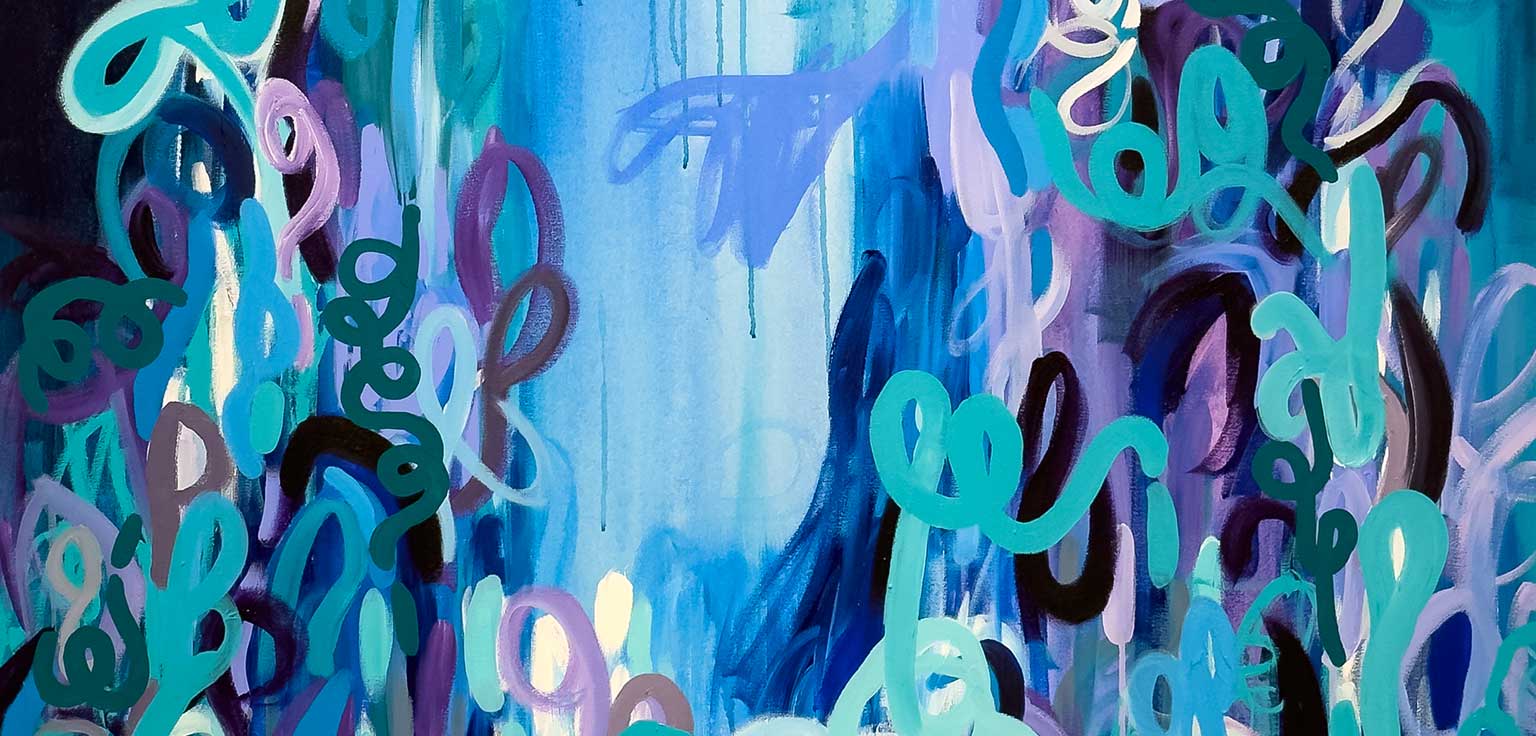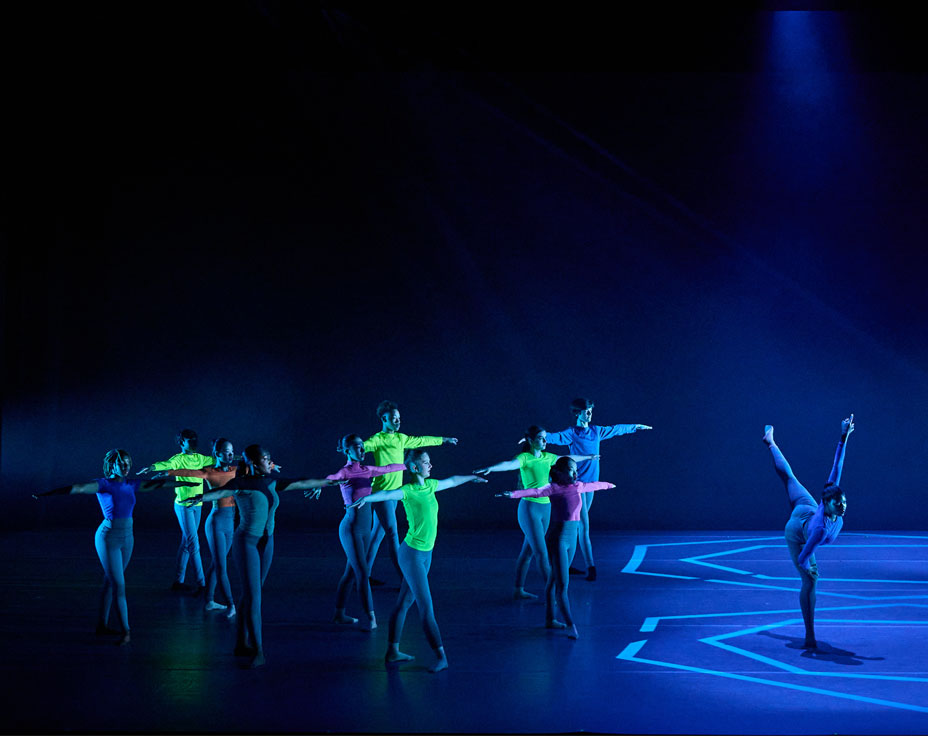When artist Lauren Younge told me the name of her exhibition Breathe, my mind went directly to the abstract quality of her craft. Of course, I thought. Even when we are more aware, breathing is an elusive process that can only appear through movement and color, unbounded to a concrete form. What I don’t anticipate, however, is that breathing is also what the artist is encouraging us to do in front of her compositions. It is only through breathing that both the paintings and the viewer’s sense of time deepen. In this conversation, Younge and I traced the reflections that gave origin to the exhibition and her expectations for the gallery visitors.
Karla: Tell me more about your preference for abstraction. When did you decide that was the channel for your creativity?
Lauren: I received a really traditional education. I went to undergrad for an art education degree and had all the classes you can imagine for formal training. Still, I realized abstraction was for me, I would say, by high school when I was taking visual art classes that helped me create my portfolio. I realized I could make a portrait and that I had the skill to draw a landscape, but I had more freedom in abstract art. My painting teacher at the time was fantastic in helping me find ways to explore that more.
Karla: What is it about abstraction that makes you feel free?
Lauren: With abstract art, I am making my own rules. I am the one who decides when the piece is finished. With realistic work, I found myself more constrained because if I was trying to draw a flower, it needed to look exactly like that, and I never felt confident with art like that, but abstract art was more fun. It was stress-free. I can paint something that looks like a flower, but it’s not going to be an exact replica, and that was more interesting to me. And I find myself more inspired by the idea of me being in charge, as opposed to trying to replicate something. This way, I can play with colors, I can play with texture. It’s almost as if I can experiment every time I work, whether it is a continuation of a body of work I created before or something new.
Karla: Something we have discussed a lot through the planning of the exhibition is your usage of color: the combination of opposite palettes, or for instance, the importance that blue has for your understanding of breathing. How do you decide the association’s color meaning? When do you know it is time for a warmer color instead of a cooler one?
Lauren: This is the first time I have restricted myself to a cooler palette for some pieces. Through years of finding my style and what I like to explore when painting, I am now aware of what colors work together. Before I start a painting, I know my “go-to” colors. I know, for instance, that I like to begin with deeper values and then go with lighter and lighter. I found that makes my color stand out more…
Karla: It’s like seeing the color with personalities and deciding which color you have a better relationship with…
Lauren: Yes, this sounds weird, but my first few layers always start the same. I am using Prussian Blue, the deepest blue I’ve found, which looks like black, but it’s blue. I always start with blue or deep purples or greens to get my dark tones, and then it depends on the white space left, and I decide from there. It just depends…
Karla: So it really is an unconscious process…
Lauren: Yes, and it is like a risk because I am the “coverup queen.” If I am on layer three, which could be three or four days after beginning a piece, and I am not feeling it, I let my… you could say like an intuition to work. It’s an instinct that tells me when to stop or if something needs more. It comes naturally, so it is hard to explain, but it was vital for me to have a couple of pieces, mainly blue because that is what I envision when I think of breathing, the color I imagine for air, those cool tones.
Karla: I want to come back to the idea of “layers.” It’s tough to find the “original” background in your paintings. What is the significance of that covering process for you? Does it have to do with color’s interaction?
Lauren: The fact that my pieces never looked at the beginning like how they are in the end, is a lot of fun. I think the more you use a canvas, the more exciting it is. I am doing a little color theory but without that much thought. I know that if I have lavenders and deep purples, a yellow will look nice next to them. I may use a bright pink for the final layer if I have greens. Let’s call it a “quick color theory,” And sometimes I just go for it, especially when the piece is almost finished. I might add some golden dots, for instance. I would not say that I am hiding how a painting starts, but those layers must always grow for me.
Karla: You mentioned the relationship between colors—specifically blue and breathing, but what about movement? There is a lot of it in your compositions. Do you relate breathing with a specific type of movement, or is moving part of your artistic practice in general?
Lauren: I think it’s important to mention that some of the pieces in the exhibition are more literal in terms of their relationship with breathing: the “blue ones” are what I envision as a big breath into the atmosphere. Movement is something I can break away from my practice; I don’t know why. It makes it more exciting for the eye. It’s more fun to paint or to create with as well. So, yes, there is a correlation between breathing and movement in some pieces, but in others, it is just because it looks fun. That is an essential component of my art. I am having fun doing it, so I want you to feel happy when you see it. I always want to know the viewer’s opinion on what I am trying to depict.
Karla: Now that we are talking about the viewers. You added to the description of the show, “a moment of gratitude and rest.” We are going to have an interactive wall where people will write their own journal entries. What kind of experience do you envision for the gallery visitors?
Lauren: I hope the viewers can be vulnerable in front of my pieces and explore how the work makes them feel. Maybe there is a memory that emerges from the painting, or maybe you just like the color. I encourage them to make their interpretation of the paintings. I also want them to read the moments of gratitude I’ve done. That is new for me: showing part of my journaling process. I wish they could find a moment inside the gallery to reflect on what they’re grateful for. No matter our backgrounds, I believe we can all take a moment and think about what things we are glad to have in our lives. I am hoping they feel a little lighter after feeling the art. I always hope my work generates warmness and joy in the viewers.

